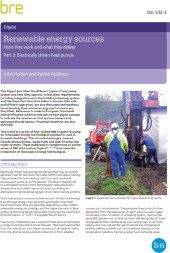Renewable energy sources: how they work and what they deliver: Part 3: Electrically driven heat pumps DG 532 3
BRE (Building Research Establishment) is an independent, research-based consultancy, testing and training organisation, operating in the built environment and associated industries.
Renewable energy sources: how they work and what they deliver: Part 3: Electrically driven heat pumps (DG 532/3) was written by John Holden and Patrick Robinson and published by BRE on 5 December 2014.
This is one in a series of four BRE Digests focusing on renewable energy technologies commonly used in domestic buildings, which complements an earlier series of BRE information papers about the installation of renewable energy technologies. The other technologies covered include:
Electrically-driven heat pumps are devices that may be used to generate heat for domestic hot water (DHW) and space heating. They achieve this by extracting heat from environmental sources such as the air or the ground. The heat is transferred to a refrigerant circuit where compression raises the fluid’s temperature and useful heat is extracted, providing an alternative to conventional gas or oil-fired heating systems.
DG 532/3 describes different types of heat pump system and how they operate. It also discusses installation requirements (including integration with the building’s heating system and the steps that should be taken to ensure their safe and efficient operation) and methods for estimating annual energy performance.
Reference is made to European Standards and certification schemes relevant to heat pump systems to indicate the assurances that system owners and operators should expect. Financial incentives are also outlined.
Its contents are:
- Introduction.
- How heat pumps work.
- Heating system design.
- Building characteristics.
- Evaluation of performance.
- Operating costs.
- Operating incentives.
- Conclusion.
- References.
[edit] Related articles on Designing Buildings Wiki
- Absorption heat pump.
- Air source heat pumps.
- BRE articles on Designing Buildings Wiki.
- BRE Buzz articles on Designing Buildings Wiki.
- BRE Buzz.
- BREEAM.
- BSRIA domestic hot water heat pumps testing.
- Domestic heat pumps and the electricity supply system.
- Dynamic thermal modelling of closed loop geothermal heat pump systems.
- Earth-to-air heat exchangers.
- Exhaust air heat pump.
- Ground source heat pumps.
- Heat pump.
- Renewable energy sources: how they work and what they deliver: Part 4: Solar thermal hot water systems DG 532 4.
- Residential heat pump installations: the role of vocational education and training.
- Solar-assisted heat pump.
- Water source heat pumps.
Featured articles and news
RTPI leader to become new CIOB Chief Executive Officer
Dr Victoria Hills MRTPI, FICE to take over after Caroline Gumble’s departure.
Social and affordable housing, a long term plan for delivery
The “Delivering a Decade of Renewal for Social and Affordable Housing” strategy sets out future path.
A change to adoptive architecture
Effects of global weather warming on architectural detailing, material choice and human interaction.
The proposed publicly owned and backed subsidiary of Homes England, to facilitate new homes.
How big is the problem and what can we do to mitigate the effects?
Overheating guidance and tools for building designers
A number of cool guides to help with the heat.
The UK's Modern Industrial Strategy: A 10 year plan
Previous consultation criticism, current key elements and general support with some persisting reservations.
Building Safety Regulator reforms
New roles, new staff and a new fast track service pave the way for a single construction regulator.
Architectural Technologist CPDs and Communications
CIAT CPD… and how you can do it!
Cooling centres and cool spaces
Managing extreme heat in cities by directing the public to places for heat stress relief and water sources.
Winter gardens: A brief history and warm variations
Extending the season with glass in different forms and terms.
Restoring Great Yarmouth's Winter Gardens
Transforming one of the least sustainable constructions imaginable.
Construction Skills Mission Board launch sector drive
Newly formed government and industry collaboration set strategy for recruiting an additional 100,000 construction workers a year.
New Architects Code comes into effect in September 2025
ARB Architects Code of Conduct and Practice available with ongoing consultation regarding guidance.
Welsh Skills Body (Medr) launches ambitious plan
The new skills body brings together funding and regulation of tertiary education and research for the devolved nation.
Paul Gandy FCIOB announced as next CIOB President
Former Tilbury Douglas CEO takes helm.
UK Infrastructure: A 10 Year Strategy. In brief with reactions
With the National Infrastructure and Service Transformation Authority (NISTA).
























